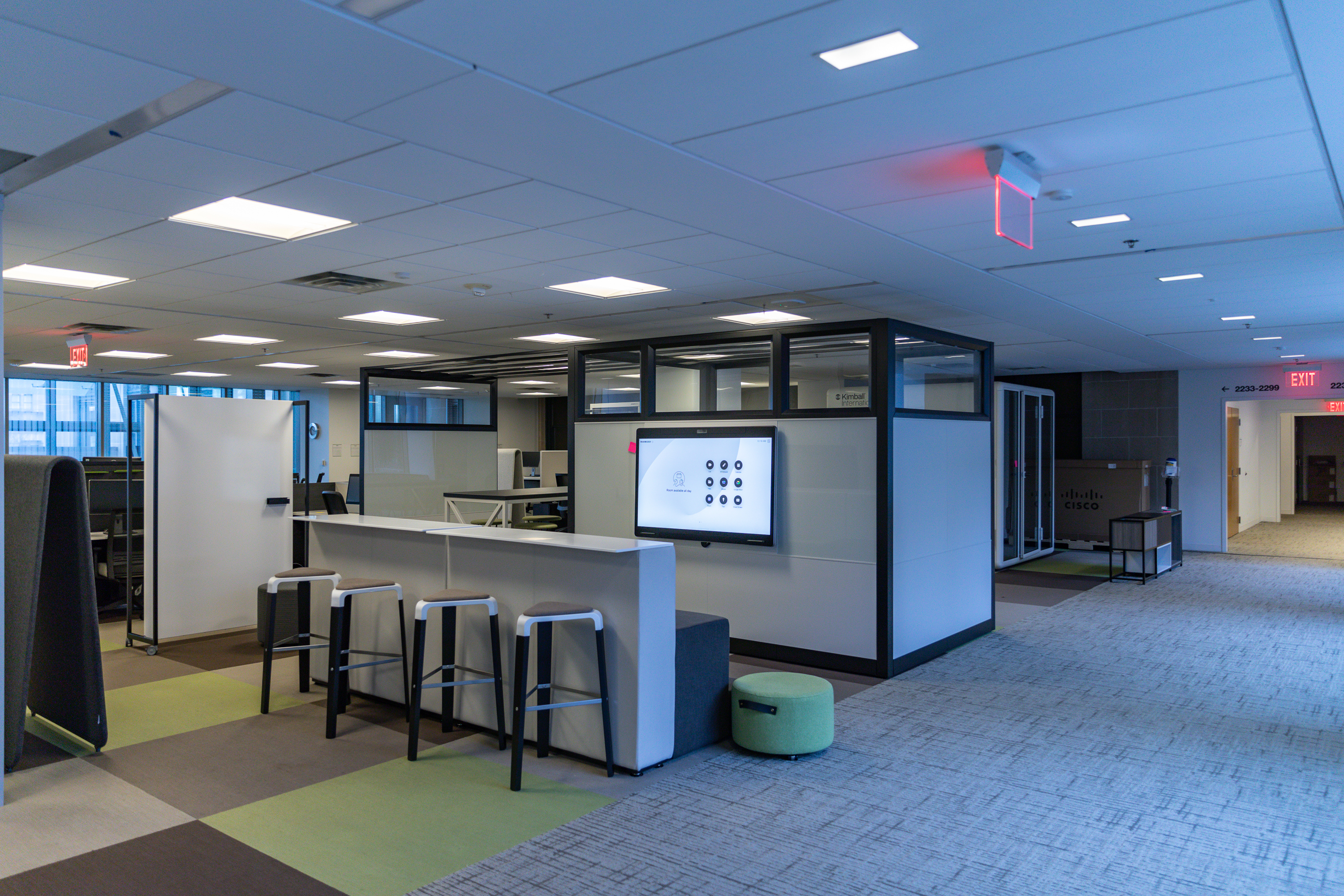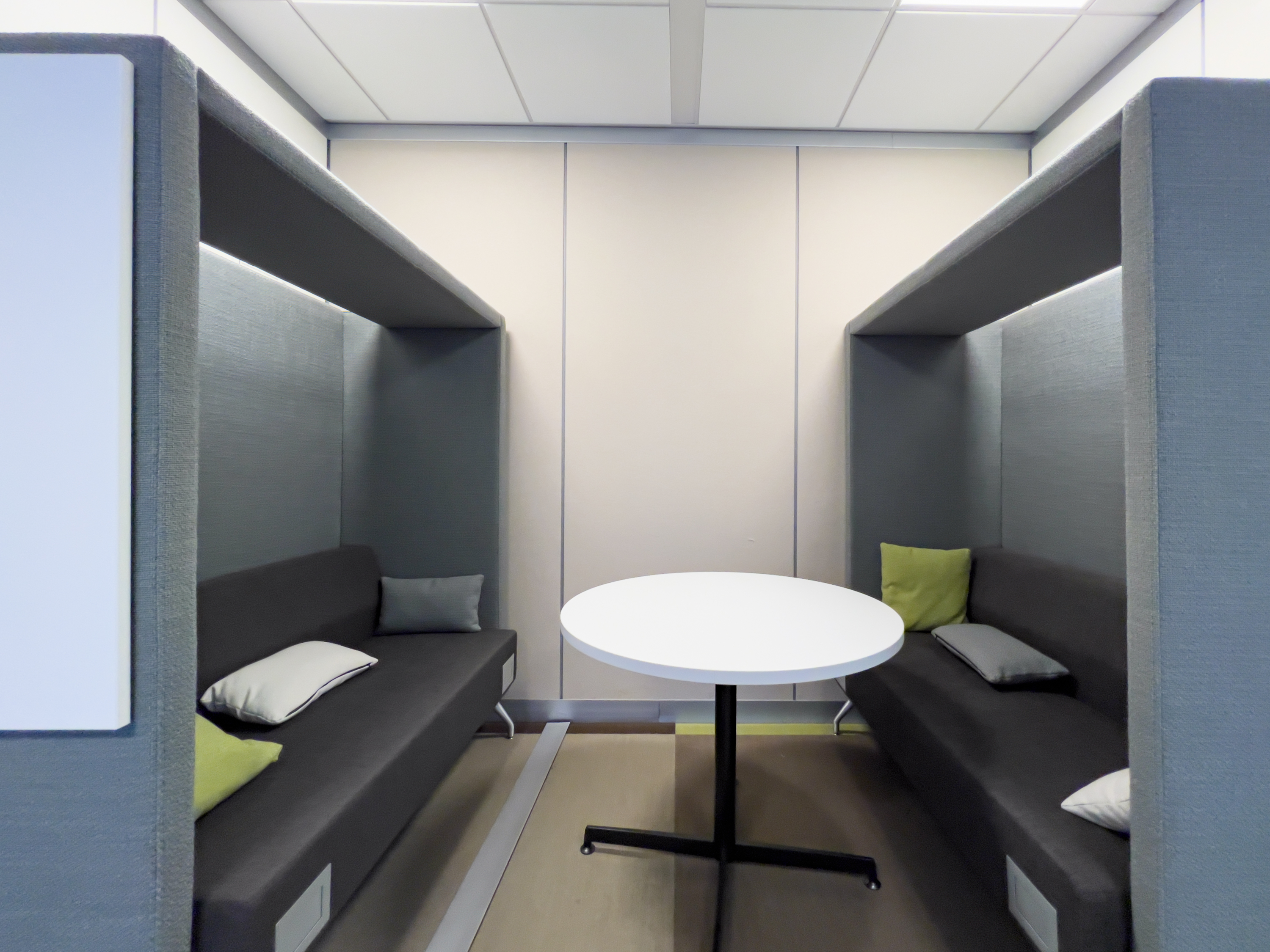
From left, Lisle Hannah, director of the Office of Facilities and Environmental Quality at the Commerce Department; Nina Albert, commissioner of the Public Buildings Service; Robin Carnahan, GSA administrator; Katy Kale, deputy administrator of GSA; and Chuck Hardy, GSA chief architect, take part in a ribbon cutting ceremony for the new space. GSA
Couch, Private Meeting Booth or Desk? Feds Can Come Try Out New Office Digs in D.C.
This is part of GSA’s “workplace 2030” initiative as federal agencies work on their post-pandemic plans.
The federal government's landlord on Wednesday officially opened its doors for federal agencies to come try out innovative works spaces and equipment, as part of its larger future of work planning.
The General Services Administration’s workplace innovation lab, located at its headquarters in Washington, D.C., is part of its “workplace 2030” initiative that was launched earlier in the COVD-19 pandemic, but also stems from the agency’s years long work on innovative workspaces.
“The future of the office workplace is now. We’re imagining it and building it right here in partnership with both industry innovators and our federal customers,” GSA Administrator Robin Carnahan said in a statement. “This is a space where agency decision makers and their teams can experience the latest technologies, equipment and furniture that’s designed to empower federal employees to deliver even more effectively.”
GSA is operating the lab as a federal coworking spaces pilot program as well as a showroom for agencies to see if they want to purchase any of the equipment or technology (which is not custom made) themselves. GSA has partnered with the vendors Allsteel, Cisco, Haworth / Price Modern, Miller-Knoll, Kimball International and Swiftspace / VOE, each of which have their own suite (as does GSA itself for its own offerings). After a year, GSA will assess whether to renew the agreements. Federal employees can work in the space from an hour to several weeks, and they can book it on a new online platform: http://www.gsa.gov/workplace/offerings/innovation-lab. Tours are also available to check out the space.
The offerings range from living room style seating to private meeting booths to formal conference seating to computer stations, all of which are equipped with technology to facilitate video calls on the various platforms and to accommodate different types of work, whether that’s crisis response, informal meetings, a general workday or something else. Agencies don’t need to pay or sign an agreement to use the space during the pilot.
Some photos of the space can be seen below, and a photo gallery can be found here.

Chuck Hardy, GSA’s chief architect, told reporters the key themes of the lab are “agility, flexibility, choice and variety.” There are also many sustainability aspects, such as solar powered light fixtures that will support GSA’s push for net zero carbon facilities. He said GSA will be looking for feedback on how employees like the offerings.
GSA also has a commercial coworking spaces initiative with WeWork and several other vendors that agencies can use if they need an off-site location in a new city or swing space for up to a year, Nina Albert, commissioner of GSA’s Public Buildings Service, told reporters. What was opened on Wednesday is “more of an experimental real time space that's available to agencies,” she said. “Ultimately, we see the federal government potentially creating co-working hubs where any agency can come and use it and we would distribute that across the country.” In addition to D.C., GSA is also planning to have federal coworking spaces in Denver and San Francisco.

For years, GSA has been working to right-size its buildings portfolio, and changes resulting from the pandemic have been a factor in this process.
“The future for the federal portfolio is fewer buildings, but better buildings,” Albert said. “The quality of space has to be better in order to entice people. But the most important thing is that people are the amenity that others are seeking most.”
The launch of the lab comes after Washington D.C. Mayor Muriel Bowser released her “comeback plan” for the city on January 9, which said the city “is losing population to neighboring counties, particularly working-age adults,” and “the federal government’s stalled return to office and shrinking office footprint exacerbates this threat (federal government accounts for ~190K jobs).” This built on her remarks during her swearing-in ceremony earlier this month.
Albert said GSA officials have spoken with the D.C. government and noted “this is a work in progress for all of us, for all employers.” The federal government has a “big footprint” in D.C. and “I think that the district's being very proactive with all of its employers, trying to figure out what are the strategies for keeping the vibrancy––that's historically been in D.C.––alive.
.jpg)
For a while now, Republicans have been pushing for federal employees to be back in their offices fulltime. Meanwhile many agencies have been expanding flexibilities maximized early on in the pandemic. Even if House Republicans, now in the majority, are able to pass legislation on this, it would need to get past the Democrat-controlled Senate and White House.
Rep. James Comer, R-Ky., the newly installed chair of the House Oversight and Accountability Committee, introduced the Stopping Home Office Work’s Unproductive Problems Act this month, which would require agencies “reinstate and apply the telework policies, practices and levels … in effect on December 31, 2019,” within 30 days of enactment. So far, the bill only has Republican co-sponsors.
When asked about bills such as that one, Albert underscored the importance of each agency having their own unique needs and that hybrid work in the government has been around for a while, yet if such legislation were to be enacted then all managers would work accordingly.
While this speaks to the current zeitgeist, GSA is not new to workplace innovations. GSA has been working in a hybrid environment for over 20 years, Albert noted. Also, “there was a ‘workplace 2020,’ there was a ‘workplace 2010’,” she said. “Almost every decade we sort of refresh what the trends and tools and ways of working are.” Now, “the future is about choice.”







